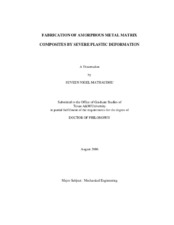| dc.description.abstract | Bulk metallic glasses (BMGs) have displayed impressive mechanical properties, but
the use and dimensions of material have been limited due to critical cooling rate
requirements and low ductility. The application of severe plastic deformation by equal
channel angular extrusion (ECAE) for consolidation of bulk amorphous metals (BAM)
and amorphous metal matrix composites (AMMC) is investigated in this dissertation.
The objectives of this research are a) to better understand processing parameters which
promote bonding between particles and b) to determine by what mechanisms the
plasticity is enhanced in bulk amorphous metal matrix composites consolidated by
ECAE.
To accomplish the objectives BAM and AMMCs were produced via ECAE
consolidation of Vitreloy 106a (Zr58.5Nb2.8Cu15.6Ni12.8Al10.3-wt%), ARLloy #1
(Hf71.3Cu16.2Ni7.6Ti2.2Al2.6 -wt%), and both of these amorphous alloys blended with
crystalline phases of W, Cu and Ni. Novel instrumented extrusions and a host of postprocessing
material characterizations were used to evaluate processing conditions and
material properties. The results show that ECAE consolidation at temperatures within the supercooled liquid region gives near fully dense (>99%) and well bonded millimeter
scale BAM and AMMCs. The mechanical properties of the ECAE processed BMG are
comparable to cast material: Ãf = 1640 MPa, εf = 2.3%, E = 80 GPa for consolidated
Vitreloy 106a as compared to Ãf = 1800 MPa, εf = 2.5%, E = 85 GPa for cast Vitreloy
106, and Ãf = 1660 MPa, εf = 2.0%, E = 97 GPa for ARLloy #1 as compared to Ãf = 2150
MPa, εf < 2.5%, E = 102 GPa for Hf52Cu17.9Ni14.6Ti5Al10. The mechanical properties of
AMMCs are substandard compared to those obtained from melt-infiltrated composites
due to non-ideal particle bonding conditions such as surface oxides and crystalline phase
morphology and chemistry. It is demonstrated that the addition of a dispersed crystalline
phase to an amorphous matrix by ECAE powder consolidation increases the plasticity of
the amorphous matrix by providing locations for generation and/or arrest of adiabatic
shear bands. The ability of ECAE to consolidated BAM and AMMCs with improved
plasticity opens the possibility of overcoming the size and plasticity limitations of the
monolithic bulk metallic glasses. | en |


